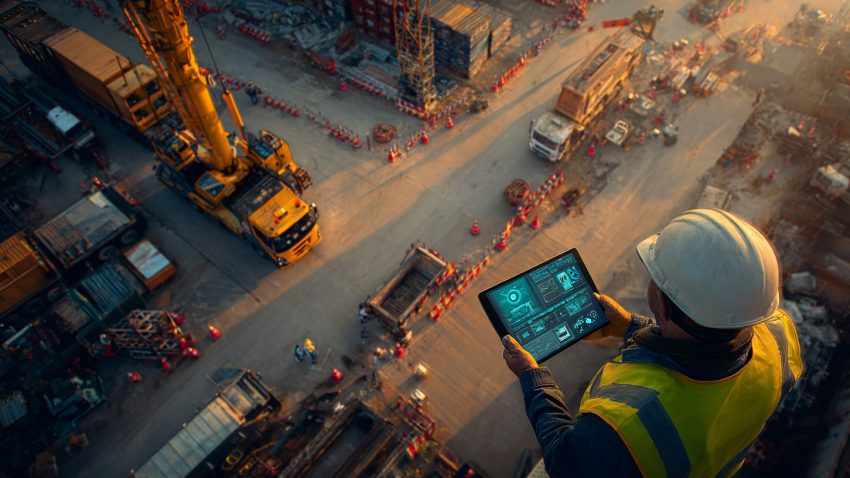Cybersecurity in AI-Driven Construction: Top 12 Tips for Safeguarding Data and Privacy for Superintendents in Commercial Construction Projects
Table of Contents:
Welcome to the digital age of construction where AI-driven tools are revolutionizing the way we manage commercial construction projects. But with great power comes great responsibility, especially when it comes to cybersecurity. As a superintendent, it’s crucial to protect your project from digital threats just as diligently as you would from physical ones. So, let’s deep dive into the world of cybersecurity in AI-driven construction and explore how you can safeguard your data and privacy effectively.

The Rise of Cybersecurity Challenges in Construction
In an era where construction projects are increasingly digitized, the risk of cyber threats looms larger than ever. From project planning to execution, a significant amount of sensitive data is shared and stored online. This makes commercial construction projects a tempting target for cybercriminals. Understanding these risks and preparing for them is not just a good practice; it’s an essential part of your job.
Why Superintendents Need to Be Cyber-Savvy
As a superintendent, you’re not just overseeing construction activities; you’re also managing a vast amount of digital information. This includes everything from architectural plans to employee records. A breach in cybersecurity can lead to data theft, financial loss, and even legal complications. That’s why being cyber-savvy is no longer optional; it’s a necessity.
Now, let’s walk through the top 12 tips to keep your digital space as secure as your construction site.
1. Understand the Basics of Cybersecurity
The Foundation of Digital Defense
Just like a solid foundation is crucial for any building, understanding the basics of cybersecurity is essential for protecting your digital assets. Cyber threats come in various forms – malware that can disrupt your systems, phishing attacks that can trick you into giving away sensitive information, and ransomware that can hold your data hostage. By understanding these threats, you can identify vulnerabilities in your system and take steps to address them.
2. Use Strong, Unique Passwords
Your Digital Keys
Think of passwords as the keys to your digital kingdom. Using strong, unique passwords for different accounts is like having a different key for every door. Avoid common passwords that are easy to guess, like “password123” or “admin.” Instead, use a mix of letters, numbers, and symbols. Regularly updating your passwords is also crucial. Consider using a password manager to keep track of all your different passwords securely.
3. Implement Multi-Factor Authentication (MFA)
An Extra Layer of Security
Multi-factor authentication (MFA) adds an additional security layer, much like a double-door entry system in a building. With MFA, accessing an account requires more than just a password; it also needs a second form of verification, like a fingerprint or a code sent to your phone. This makes it much harder for unauthorized users to gain access to your systems, even if they have your password.
4. Regularly Update Software and Systems
Keeping Your Digital Tools Sharp
Regular updates are vital for keeping your software and systems secure. Software developers often release updates to patch security vulnerabilities. Ignoring these updates is like leaving a window open on a construction site; it’s an invitation for trouble. Set your systems to update automatically or set a regular schedule to check for updates.
5. Train Your Team on Cybersecurity Practices
Building a Cyber-Aware Workforce
Your team is your first and most critical line of defense against cyber threats. Regular training on cybersecurity best practices can empower your team to recognize and avoid potential threats. Teach them how to identify suspicious emails, the importance of using secure networks, and the proper handling of sensitive data. Remember, a well-informed team is your strongest asset in the fight against cyber threats.
6. Secure Your Mobile Devices
Protecting Your Portable Gateways
In the field, mobile devices are often used to access project data. These devices can be vulnerable to security breaches, especially if they are lost or stolen. Securing your mobile devices with strong passwords, encryption, and remote wipe capabilities is crucial. It’s like having a contingency plan for your most portable assets.

StruxHub
Discover how StruxHub can revolutionize your construction management. Contact us today!
7. Use Trusted Cloud Services
Choosing the Right Digital Partners
When it comes to storing project data, not all cloud services are created equal. Opt for cloud providers known for their robust security measures. Research their security protocols, compliance certifications, and user reviews. It’s similar to vetting subcontractors; you want to ensure they’re reliable and up to the task.
8. Limit Access to Sensitive Data
The Principle of Least Privilege
Access to sensitive data should be on a need-to-know basis. Implement access controls to ensure that each team member can only access the information necessary for their role. This approach minimizes the risk of accidental or intentional data breaches. It’s like restricting site access to authorized personnel only.
9. Regularly Back Up Data
Your Digital Safety Net
Regular backups of your data can be a lifesaver in case of a cyberattack or data loss. Ensure you have a reliable backup system in place, and test it regularly. Backups should be stored securely, either in a different location or in the cloud. Think of it as having a backup generator; you hope you never need it, but it’s essential if the power goes out.
10. Monitor Network Activity
Keeping a Watchful Eye
Monitoring your network activity is crucial for detecting unusual patterns or breaches. It’s like keeping a constant watch on your construction site. Use network monitoring tools to keep an eye on your network traffic and immediately investigate any anomalies.
11. Have a Response Plan for Cyber Incidents
Preparedness is Key
Just as you have an emergency response plan for onsite incidents, you need a plan for cyber incidents. This should include steps to take in the event of a breach, including who to notify, how to contain the threat, and how to recover lost data. A well-prepared response plan can minimize the damage and restore operations quickly.
12. Stay Informed About Latest Cybersecurity Trends
Staying Ahead of the Curve
The world of cybersecurity is constantly evolving. Keeping yourself updated on the latest trends, threats, and protective measures can help you stay one step ahead of cybercriminals. Subscribe to cybersecurity newsletters, attend webinars, and participate in relevant workshops.
As a superintendent in the AI-driven construction world, cybersecurity should be one of your top priorities. By implementing these 12 tips, you can significantly enhance the security of your digital assets, safeguard your project data, and protect the privacy of all stakeholders involved. Stay safe, both on and off the construction site!
StruxHub is a construction project management software that helps you manage projects from start to finish. It offers features like task management, document management, and communication tools. StruxHub can help you save time and money, improve communication, collaboration, and decision-making.
To learn more about how StruxHub can streamline your construction management processes, request a demo today. By completing our form, you’ll hear from our team soon to discuss how StruxHub can help you:
- Schedule construction material deliveries with your trades
- Coordinate construction site resources and on-site logistics
- Digitize work permits and inspection forms
- Communicate and track P6 and Excel schedules
- Broadcast announcements to all construction workers
Don’t miss out on the opportunity to optimize your construction management processes with StruxHub. Sign up for a free demo today.



